Beneath the relentless waves and vast expanse of the ocean lies a critical artery of global communication: submarine communication cables. These undersea paths, hidden from view, connect continents and facilitate nearly all of our international data transmission. From humble beginnings in the mid-19th century with the first cable laid across the English Channel, to the sprawling networks of today, these cables are technological wonders that form the backbone of our digital world.
The journey of submarine cables is a tale of groundbreaking engineering feats. Engineers face formidable challenges as they deploy cables across unpredictable ocean terrains, from sharp underwater cliffs to deep, dark trenches. The process employs state-of-the-art vessels equipped with sophisticated technology, capable of laying cables with pinpoint accuracy over thousands of miles.
Yet, laying these cables is just the beginning. Maintaining them against natural adversities such as ocean currents, earthquakes, and even human threats like ship anchors and fishing operations requires constant vigilance and innovation. Specialized repair ships are always at the ready, prepared to fix breaks and faults swiftly to keep the information flowing uninterrupted.
Index:
- Pioneering the Depths – The Dawn of Undersea Communication
- Bridging the Ages – From Telegraph to Fiber Optics
- The Role of Submarine Cables in Global Connectivity
- Protecting the Lifelines: Maintenance and Security Strategies
- The Horizon Ahead: Innovations and Challenges in Submarine Cabling
- References

Join us as we dive deeper into the dynamic saga of submarine communication cables, exploring their pivotal role in our interconnected era and the continuous efforts to safeguard this hidden infrastructure.
Chapter 1: Pioneering the Depths – The Dawn of Undersea Communication
The journey of submarine communication cables began not with a whisper, but with a bold, ambitious splash in the waters of the English Channel in 1850. It was here that brothers Jacob and John Watkins Brett envisioned a world more connected than ever before. They formed the English Channel Submarine Telegraph Company, embarking on a pioneering project that would come to link the shores of England with France through a slender thread of technological innovation.
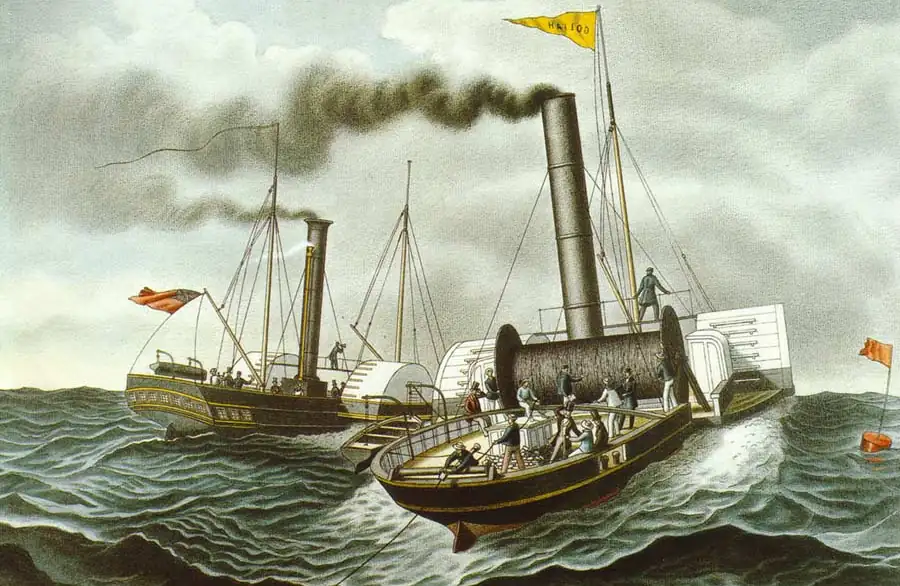
The Bretts faced monumental challenges from the start. Their initial attempt in 1850 to lay a cable was met with both skepticism and technical difficulties. The cable itself, supplied by the Gutta Percha Company, was a simple construction—merely a single wire with gutta-percha insulation. Without any armouring to protect it, the cable was vulnerable, but the vision persisted. Amidst growing anticipation and against a backdrop of technological naivety, the cable was laid. However, this initial line was short-lived, severed by a fisherman’s anchor within just a few hours of its completion.
Despite this setback, the determination of the Bretts was unshaken. By 1851, they streamlined their operations, shortening the company’s name to the Submarine Telegraph Company and refocusing their efforts. Their second attempt was meticulously planned and executed with improved technology. This cable, more robust than its predecessor, was successfully laid and became the first operational undersea telegraph cable, heralding a new era in global communication.
The success of the 1851 English Channel cable lit a fire under the ambitions of others, most notably an American entrepreneur, Cyrus West Field.

Field was captivated by the idea of connecting continents. His vision was grander: a transatlantic telegraph cable. The undertaking began in 1854 with the formation of the Atlantic Telegraph Company. Field’s project was plagued by greater distances and deeper waters, presenting a multitude of technical and financial obstacles that made the English Channel project seem trivial in comparison.
Field’s first attempts were fraught with failure. The vast Atlantic proved a formidable opponent, swallowing miles of cable into its depths without a trace. In 1857 and again in 1858, attempts to lay the cable met with technical failures that tested the resolve of the bravest souls. It wasn’t until 1858, after much trial and error, immense financial cost, and the use of the newly built ship, the SS Great Eastern, that the transatlantic cable was successfully laid.
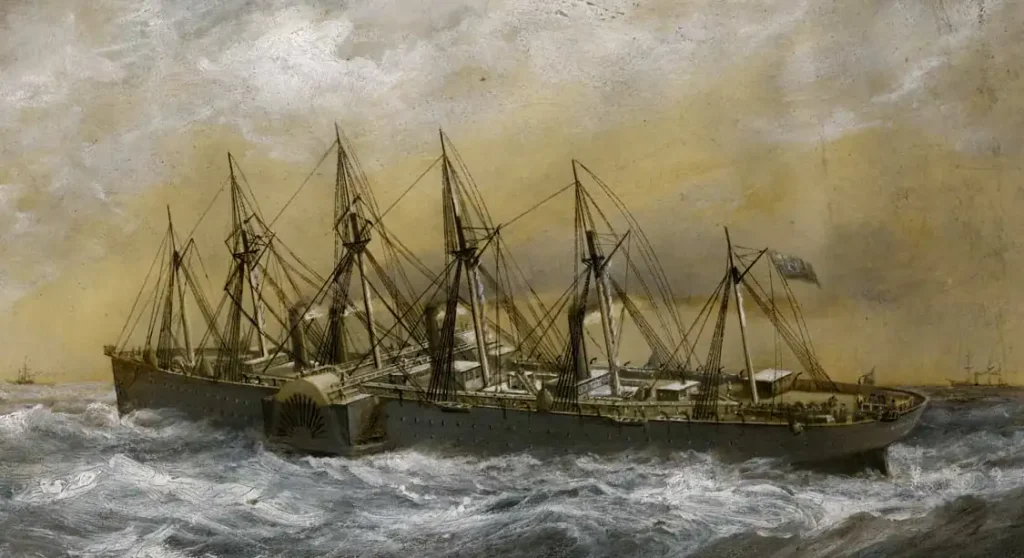
This cable, though operational for only a brief period before succumbing to electrical faults, marked a monumental achievement in engineering and human perseverance. The brief communication it facilitated between Queen Victoria and President James Buchanan served as a proof of concept that would shape the future of global communications.
The trials faced by these early endeavors were manifold: technical limitations of the era, the sheer unpredictability of oceanic conditions, and the daunting financial risks. Yet, the pioneers of submarine cabling, like the Bretts and Field, were driven by a relentless pursuit of connectivity. Their efforts laid the groundwork for our modern, interconnected world, proving that with resilience and innovation, even the greatest barriers can be overcome.
Through storms and setbacks, these visionaries wove a web of connectivity that stretched across treacherous waters, binding continents and cultures. Their story is not merely one of technology, but a testament to human ingenuity and the unyielding quest to shrink the vast distances of our world. As we delve deeper into the history and impact of these monumental achievements, we continue to uncover lessons about courage, innovation, and the endless potential of human collaboration.
Chapter 2: Bridging the Ages – From Telegraph to Fiber Optics
As the last echoes of the inaugural telegraph messages faded away, the world stood on the cusp of a new era. The successful laying of the first submarine cables was not just a triumph of the moment; it was the beginning of a relentless pursuit of technological advancement that would redefine global communication. From the gritty determination of the 19th century to the high-tech precision of the modern age, the evolution of submarine cables is a saga marked by continuous innovation and grand ambition.
The Age of Expansion and the Advent of Coaxial Cables
The decades following the transatlantic triumph saw a flurry of activity, as nations across the globe sought to install their own undersea links. The early cables were rudimentary, capable only of transmitting Morse code. Yet, the demands of a shrinking world necessitated more robust communication channels. By the mid-20th century, coaxial cables had emerged. These were capable of carrying telephone signals, significantly expanding the capacity and utility of submarine cables.
This era also witnessed the Cold War’s influence on technology, including the secretive Project Jennifer, an audacious attempt by the CIA to recover a sunken Soviet submarine.
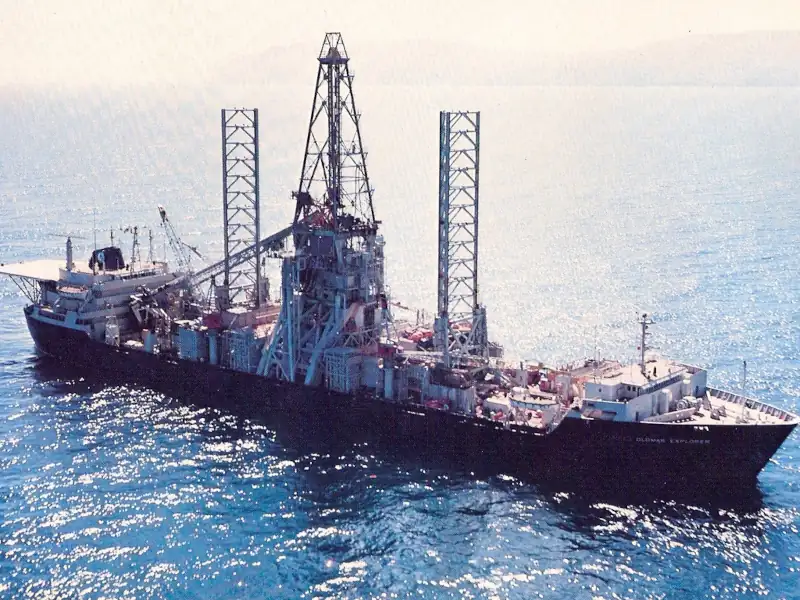
This operation inadvertently highlighted the strategic importance of deep-sea capabilities, which in turn boosted interest and investment in oceanographic research and subsea technology.
The Fiber Optic Revolution
The real transformation began with the advent of fiber optic technology in the late 20th century. Fiber optic cables, with their core of glass threads capable of transmitting data as pulses of light, were vastly superior to their metallic predecessors. They could carry vast amounts of data over long distances without the loss of signal that plagued earlier cables.
The development of this technology required breakthroughs not just in materials science, particularly in the creation of ultra-pure glass, but also in the field of lasers and optical physics. The shift to fiber optics dramatically increased the speed and volume of data transmission, propelling the global internet age forward.
Modern Marvels of Engineering and Technology
Today, the laying of submarine cables is a high-tech operation that embodies precision and innovation. Modern cable-laying ships, like the Resolute and Durable, are marvels of maritime engineering. These ships are equipped with state-of-the-art dynamic positioning systems that allow them to hold steady above precise locations in the ocean, combating the whims of currents and weather.
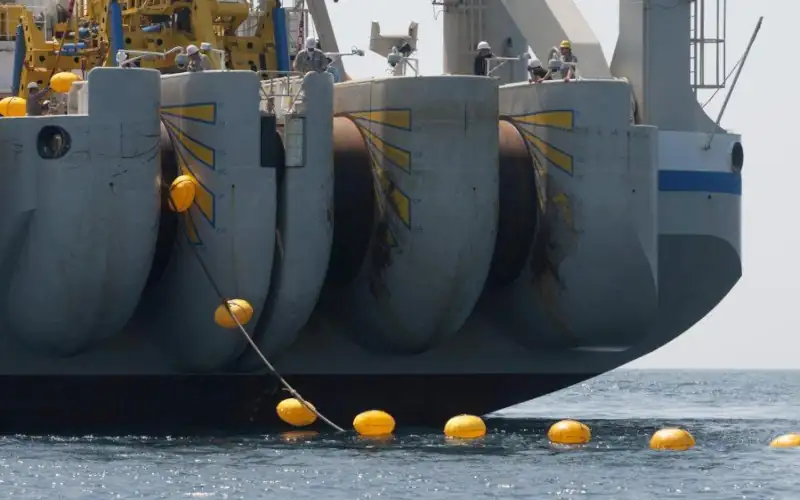
The cable itself is a product of meticulous engineering, designed to withstand harsh oceanic conditions. It is typically about an inch thick, encased in layers of protective materials including steel wire, aluminum, and polyethylene. Before deployment, each cable is tested rigorously to ensure its integrity and performance.
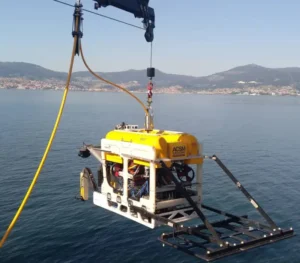
At the heart of the operation is the ROV (remotely operated vehicle), which plays a critical role in cable laying. These underwater robots are deployed to survey the ocean floor, ensuring the cable’s path is clear of obstructions and hazards such as shipwrecks or underwater volcanoes. They also assist in the precise placement and burial of the cable to protect it from natural and anthropogenic threats.
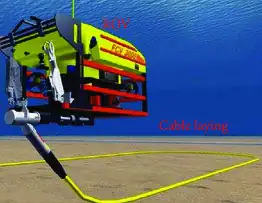
The Symphony of Coordination
The process of laying a cable is a symphony of coordination involving meteorologists, marine biologists, engineers, and navigational experts. Each cable route is carefully planned to avoid environmental and geopolitical sensitivities, with months spent in mapping and preparation.
As our journey from the gritty cables of the 1850s to the sleek fiber optics of today shows, the evolution of submarine cables is a testament to human ingenuity and the relentless pursuit of connectivity. It’s a narrative of overcoming immense challenges—both seen and unforeseen—in the quest to keep the world connected. This story is far from over, as innovators continue to push the boundaries of what these vital lifelines can achieve, promising a future where data flows as freely as the ocean currents themselves.
Chapter 3: The Role of Submarine Cables in Global Connectivity
In an era defined by globalization and digital interconnectedness, submarine cables serve as the silent sentinels of the internet age, shouldering the colossal weight of global communication. These undersea conduits are far more than mere strands of fiber; they are the steel threads that weave the fabric of our digital society, making them indispensable to our connected world.
The Backbone of the Digital Age
Every email sent, every video streamed, every webpage loaded—much of this data travels through the labyrinth of cables hidden beneath the ocean’s surface. Submarine cables are the backbone of the global internet, supporting the vast data transfer needs of billions of users. In a time when cloud computing and international communications are vital, these cables ensure that data is not only transferred quickly but also securely and reliably across continents.
The efficiency of submarine cables is unparalleled. While satellites were once touted as the future of global communication, cables have proven to be both faster and more reliable, transmitting petabytes of data with minimal latency. This capability is crucial for everything from financial trading to personal communications, where even a millisecond’s delay can be critical.
Geopolitical Undercurrents
The routes of submarine cables, often unseen, play a subtle yet significant role in global geopolitics. The placement of these cables is not merely a matter of technological or geographic necessity but is also influenced by geopolitical considerations. Countries with landing points for major cables often hold significant strategic advantages in terms of data access and surveillance capabilities.
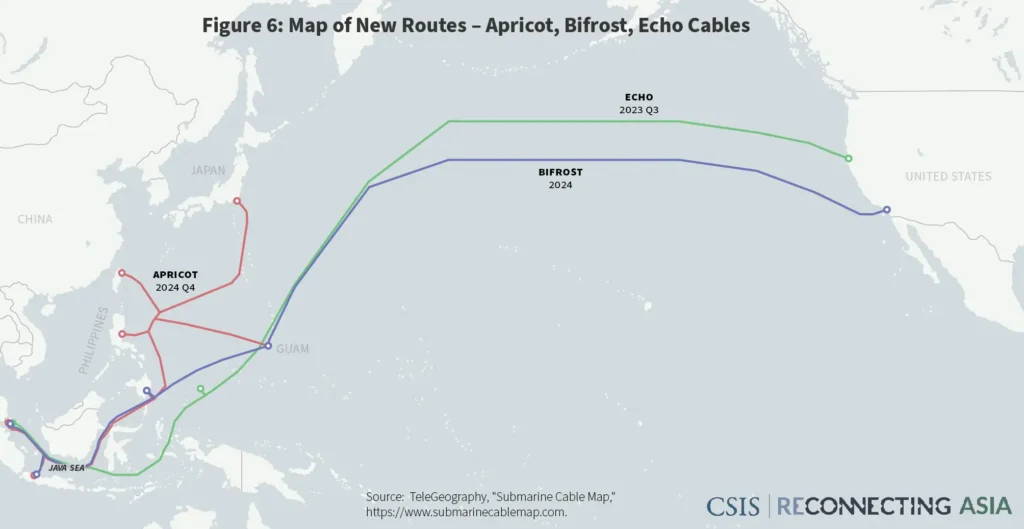
For instance, the landing points are heavily guarded and considered critical infrastructure by nations. The U.S. and China, among others, have invested heavily in expanding their networks of cables, not just to enhance connectivity but to also secure a geopolitical edge. This has led to a new kind of diplomacy and tension, sometimes referred to as “cable politics,” where the control of data routes can influence international policy and power dynamics.
A Vulnerable Artery
Despite their importance, these cables are not impervious to threats. They can be targets of sabotage, subject to territorial disputes, or accidentally severed by ship anchors or natural disasters. The redundancy of cable routes is thus critical; multiple cables usually serve the same general routes to ensure that the failure of one does not incapacitate a region.
Moreover, the security of these cables is of paramount importance. Nations and private enterprises invest heavily in monitoring and protection technologies to shield these cables from both physical and cyber threats. The integrity of submarine cables is integral to national security, economic stability, and global connectivity.
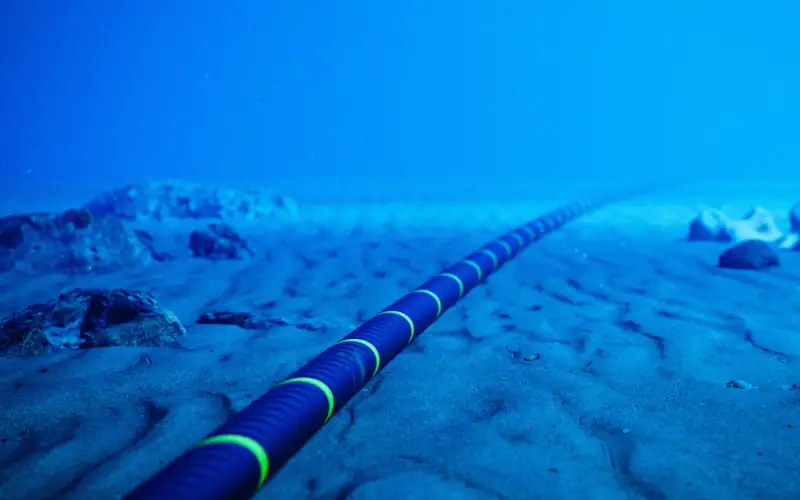
Connecting Continents, Connecting Cultures
Submarine cables do more than transmit data; they connect cultures and economies. They are the invisible force enabling the global village, where instant communication has bridged the divide between nations and peoples. They facilitate not only commerce and politics but also the more personal connections that shape our global society.
As we continue to rely more on digital technologies, the role of submarine cables will only grow. Their strategic importance—both as economic lifelines and geopolitical tools—will continue to evolve, underscoring the need for continued innovation and international cooperation in their development and protection.
Through the depths of the oceans, these cables carry the light of information, connecting distant shores with the speed of thought, and binding the world in a network of shared knowledge and understanding. This chapter of connectivity is still being written, as the demand for faster, more robust communication continues to drive the evolution of this critical infrastructure.
Chapter 4: Protecting the Lifelines: Maintenance and Security Strategies
Submarine communication cables, though robust and designed to withstand the harsh conditions of the ocean floor, are not invulnerable. They are the lifelines of our global connectivity, making their maintenance and protection paramount. This chapter delves into the meticulous care and strategic defenses deployed to safeguard these critical structures, ensuring the uninterrupted flow of global communications.
Vigilance Beneath the Waves: Maintenance Practices
The maintenance of submarine cables is a continuous endeavor, involving sophisticated technologies and coordinated efforts across international boundaries.
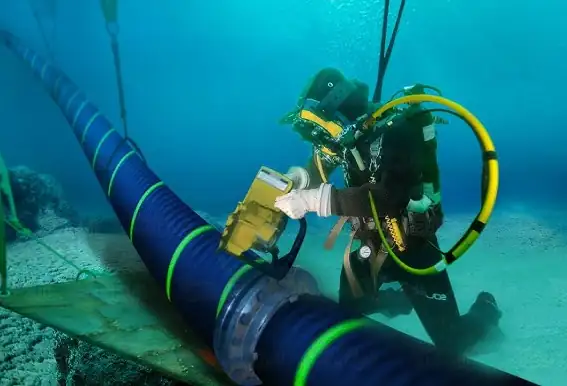
Cable-laying ships, equipped with advanced repair tools, stand ready to address any disruptions. These ships are often on high alert, positioned strategically around the globe to ensure rapid response times.
Underwater remotely operated vehicles (ROVs) play a pivotal role in routine inspections and repairs. These high-tech drones traverse the ocean floor, using cameras and sensors to inspect cables for potential damage or wear. They can perform minor repairs and are instrumental in pinpointing issues before they escalate into major faults.
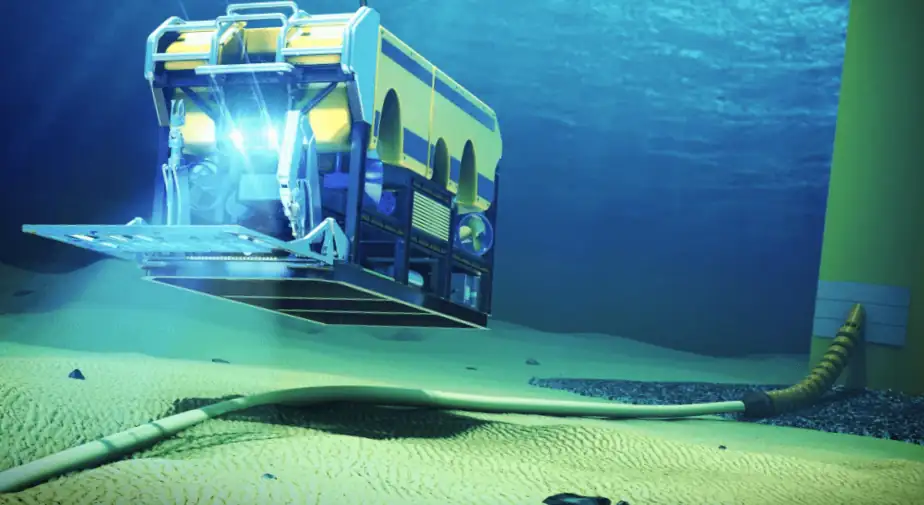
The process of maintaining these cables also involves regular monitoring of the cable routes. This monitoring is done through a combination of satellite imaging, sonar technology, and physical inspections. Companies use these data to create predictive maintenance schedules, optimizing repair operations to minimize downtime and ensure data traffic is seldom disrupted.
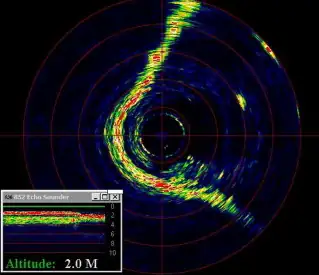
Fortresses of Fiber: Security Measures
Given their critical importance, submarine cables are prime targets for sabotage and espionage. Protecting these assets involves a layered security strategy that blends physical protection measures with advanced cybersecurity protocols.
At the physical level, cable routes are often chosen to avoid geopolitical hotspots where the risk of sabotage might be higher. Additionally, the areas around landing points—where cables are most vulnerable—are secured with enhanced surveillance and physical barriers. Some regions employ patrol boats and even underwater drones to guard against unauthorized access or tampering.
Cybersecurity measures are equally crucial. The data transmitted through submarine cables is protected by end-to-end encryption, ensuring that even if accessed, the information remains secure and unintelligible to unauthorized parties. Network operations centers monitor traffic 24/7, using artificial intelligence to detect and respond to anomalies that could indicate a cyber attack or a physical breach of the cable infrastructure.
Collaboration Across Continents
Protecting submarine cables is not solely the responsibility of individual countries or companies; it requires global cooperation. International agreements and collaborations are in place to ensure that these vital communication channels are defended against threats. Organizations such as the International Cable Protection Committee (ICPC) play a crucial role in coordinating efforts among nations and setting guidelines for the protection of submarine cables.
Furthermore, emergency response protocols are standardized across the industry, allowing multiple stakeholders to work in concert when a threat is detected. These collaborative efforts are vital, as the impact of a severed or compromised cable can ripple across continents, affecting economies and governments.
The Future of Cable Security
As technology advances, so do the strategies to protect it. Future security measures could involve more advanced materials for cable sheathing, automated repair bots capable of living on the seabed, and more sophisticated surveillance technologies driven by artificial intelligence and machine learning.
The ongoing challenge of protecting these lifelines of global connectivity will only increase in complexity as our reliance on digital communication grows. Yet, through continued innovation and international cooperation, the resilience of submarine cable networks will continue to fortify the backbone of our global information society.
Through proactive maintenance and vigilant security, the global community ensures that these undersea cables continue to serve as reliable conduits of information, bridging continents and cultures in our increasingly interconnected world.
Chapter 5: The Horizon Ahead: Innovations and Challenges in Submarine Cabling
As we cast our gaze toward the future of submarine communication cables, we find a horizon brimming with promise and punctuated by challenges. This final chapter embarks on an exploration of the cutting-edge technologies shaping the future of our global connectivity, while also addressing the hurdles that lie in the path of progress.
Pushing the Boundaries with Technological Innovations
Innovation in submarine cable technology is relentless. Companies are now experimenting with hollow-core fiber optics, a groundbreaking approach that promises faster data transmission by allowing light to travel through air, or vacuum, inside the cable instead of glass. This could dramatically reduce latency and increase bandwidth, revolutionizing how data crosses oceans.
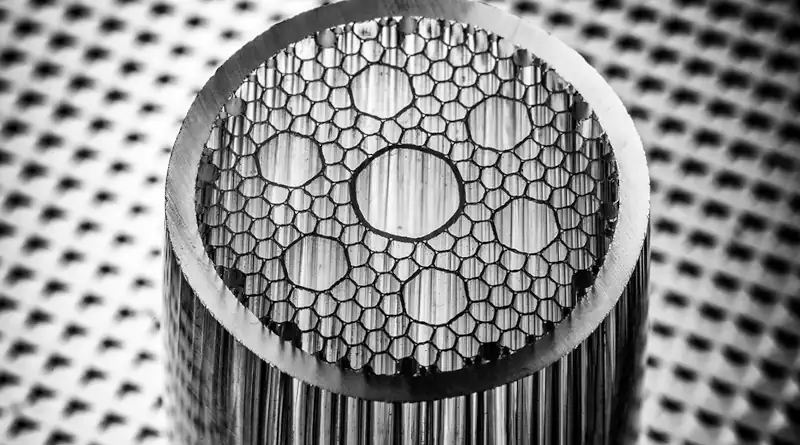
Simultaneously, the industry is improving the durability and capacity of these cables. New materials are being tested to enhance the resilience of cables to natural disruptions, such as earthquakes and underwater landslides. These materials aim to protect not just the physical integrity of the cables but also the invaluable data they carry.
Navigating Emerging Challenges
As technology advances, so do the challenges. The burgeoning demand for higher bandwidth is a testament to our increasingly connected world, driven by developments in AI, the Internet of Things (IoT), and cloud computing. This demand pressures the existing infrastructure and calls for innovative solutions in cable design and deployment.
Environmental concerns also come to the forefront. The deep-sea environments, where these cables lay, are sensitive and largely unexplored. The ecological impact of laying cables, coupled with the effects of deep-sea mining for necessary raw materials, poses significant environmental challenges. The industry must navigate these responsibly, ensuring that the technological leap does not come at the cost of marine ecosystems.
Geopolitical and Economic Implications
The laying of submarine cables is not merely a technical activity but also a geopolitical maneuver. Emerging markets are now entering the arena, shifting the dynamics of global connectivity. This diversification can democratize data access but also introduces new complexities in international relations and economic negotiations.
Moreover, tech giants are increasingly investing in their own cable networks, challenging traditional telecom monopolies and reshaping the economic landscape of global connectivity. This shift not only alters the control over data flows but also emphasizes the need for robust international cooperation and regulation.
Future-proofing the Network
Looking ahead, the industry focuses on future-proofing this critical infrastructure. Strategies include developing cables that can self-repair, employing AI to monitor and manage network integrity, and creating more resilient routing strategies to withstand the unpredictable challenges posed by climate change.
The Role of Global Cooperation
In the face of these advancements and challenges, international collaboration remains crucial. Protecting these vital lifelines of connectivity requires a concerted effort among nations, companies, and international bodies. Agreements on the protection and use of submarine cables ensure that these resources serve the global community equitably, maintaining open and secure channels of communication.
As we conclude our exploration of submarine communication cables, it’s clear that the journey is far from over. The horizon ahead is filled with opportunities and obstacles, each pushing the boundaries of innovation and international cooperation. In this ever-evolving narrative, the role of submarine cables remains central—connecting continents, cultures, and communities in our increasingly interconnected world.
References
- “Project Azorian”, aka “Jennifer”, Wikipedia
- “History of the Atlantic Cable & Undersea Communications“, WebSite
- “The Victorian Internet: The Remarkable Story of the Telegraph and the Nineteenth Century’s On-line Pioneers“, by Tom Standage (1998)
- “The Atlantic Cable“, by Bern Dibner (1959)
- “The Undersea Network“, by Nicole Starosielski (2015)
- “Wiring the World – The Social and Cultural Creation of Global Telegraph Networks“, by Simone M. Müller (2016)
- “International Cable Protection Committee“, provides resources and guidelines for the protection of submarine cables, including regulatory and environmental issues.
- “Submarine Cable Map“, an interactive map tool that tracks global submarine cable systems, including details on specific cables, landing stations, and network nodes.
- “TeleGeography“, a great resource for research on digital infrastructure, offering analyses on internet networks, submarine cables, and how data moves globally.
- RFC 5921: “A Framework for Multi-Service Metro Ethernet Networks”
- RFC 2544: “Benchmarking Methodology for Network Interconnect Devices”